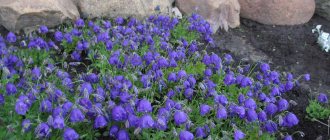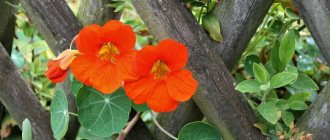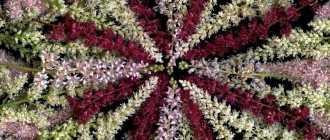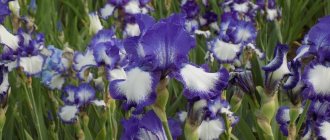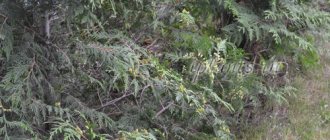Home » Flowers and plants
Vladimir 03/19/2020
9831 Views 1 comment
Daisies
There are now plenty of low-growing flowers for gardens and flower beds; breeders have learned to develop border varieties of almost any plant. Despite this, most lovers of low trunks for multi-layered flower beds still prefer to see daisies in the foreground, the cultivation of which does not require much effort. Flowers delight the eye with many bright colors; the spectrum includes various shades of red and pink, white and carmine varieties are especially valued.
general description
Daisies look beautiful not only when in bloom , their unusual lobe-shaped leaves delight the eye with lush greenery from early spring until frost.
Daisies belong to the Astrov family; officially there are more than 80 species of this biennial , which have their roots in Europe, America, and Australia. They were the first to make their way from fields to gardens; by the beginning of the 16th century, there were several terry varieties in the selection.
They were cultivated in the palace parks of England, France, and Italy. Flowers quickly spread to city parks, and not only white, but also red daisies were known.
Daisies in decorative pots
From Latin, daisy is literally translated as “pearl ,” and this is exactly what these flowers look like on lawns when they grow among short grass. A well-groomed flower bed with daisies will look a little different,
The leaves will show off with lush greenery, flowers will delight the eye several times a season. Usually the first flowering takes place in early spring, daisies take over the baton from tulips and daffodils, the second time Asters of this species will bloom closer to autumn, when the heat subsides and there is enough moisture to restore the vitality of the trunk.
It is difficult to confuse a daisy with another flower; it has a number of features:
- Small in height, daisies rarely reach 30 cm.
- The leaves sit tightly next to each other and have a lobe-like shape.
- The inflorescence has the shape of a basket.
- The flowers do not rise very much on the rosette of leaves, no more than 3-5 cm.
- The center of the flower is always yellow, framed by outer petals that have a reed or tubular shape.
Each bush at one time can please you with 30 peduncles with fully developed flowers.
The stem is classified as asteraceae and is distinguished by the following subspecies:
- simple
- semi-double
- terry
The flowering time will also vary; there are early and late varieties, the timing differs by 2-3 weeks . Flower size also divided daisies into small, medium and large-flowered varieties.
Daisies with large baskets bloom much later than all their relatives, but the period is much longer.
Daisies in landscape design
To decorate a garden with a plant, you need to choose a suitable place for it in the landscape design:
- Daisies look original against a green lawn.
- They go well with hyacinths, tulips, and daffodils.
- Harmonizes with coniferous trees.
Daisies in landscape design
To visually make the house bright, it is worth planting huge flower beds with bushes of different colors near the facade.
Varieties
Description of varieties
For decorative cultivation, out of 80 known, only 20 are used, which are conventionally divided into seven groups. Each group may include both early and late species; the size of the flower in one group may be different.
The colors of daisies are mainly divided into the following:
- white
- pink
- red
- salmon
White and red daisies
At the end of the 17th century, two-color varieties adorned the gardens and parks of many European countries; the very first was bred and planted in the parks of France ; the upper petals were red, while the lower ones remained snow-white.
This country is home to small button pom-poms, which were especially popular in Russia. Very soon, Italy presented lancet varieties with tubular baskets of inflorescences for public viewing.
If you do not care for daisies, do not thin them out, and do not feed them, they will quickly lose all their decorative characteristics and begin to bloom with ordinary simple flowers, very similar to daisies.
The distinctive features of the variety can be not only flowers, some of them are distinguished by unusual foliage:
- "Aucubaefolia" is recognized by yellow splashes on the leaves
- 'Shrewley Gold' has a unique gold pattern on the foliage along the veins
Such varieties will please the eye along with the others in spring and autumn, attracting more attention due to their characteristics.
Among the wide variety of varieties and species, there are the most popular ones, followed by a more detailed description of them:
Originator Floragran (floragran)
Daisies of this selection are new among the varieties of this garden plant, but have already been awarded several Fleroselect awards. Floragran (floragran) so far includes only one variety “Belladaisy” (belladaisy) , the rest are under development.
"Belladaisy"
"Belladaisy"
- The grown standard is characterized by small baskets of inflorescences up to 2 cm in diameter with strong doubleness; the stems grow up to 10 cm in height.
- “Belladaisy” tends to completely retain the bright pink color of the petals, and flowering occurs approximately 2.5-3 months after sowing.
- When sowing seeds, it is worth taking into account weather conditions; if the ground is not warm enough, seedlings will not appear soon.
Originator of Kieft Seed (Kieft speed)
The selection is represented by the original variety:
"Bellissima" (belissima)
"Bellissima" (belissima)
- It is characterized by pompom-type flowers with a diameter of each up to 5 cm. The basket is held at a height of more than 12 cm by a dense elastic stem. The whole range of colors is popular: red, pink, white, and two-color types.
- The first flowering occurs in the year of sowing or transplanting plants.
- An important point will be the application of fertilizers; without them, this variety will not be able to produce full flowering.
- Some species may have a pronounced yellow core; in most trunks it is not visible behind the tightly collected tubular petals.
Rob Roy
A perennial miniature semi-double plant, 15 cm high, its flowers are red in shades with needle-shaped, slightly pointed petals, the core is bright yellow. The variety prefers to grow in sunny places; only in hot midday hours does it need partial shade. For good growth, the soil needs to be moist and fertile, fertilized with humus. The species is winter hardy and unpretentious. Rob Roy can decorate a garden, plot, park or square.
Other varieties
Miniature daisies are considered less common; it is advisable to grow such varieties in small flower beds and should be given great attention. If not properly cared for, they quickly become overgrown with weeds and become almost invisible in the grass.
These include babies:
- "Dresden China" (Dresden China)
- "Liliput"
- "Alice"
Miniature daisies
Such varieties are often planted in public parks in England, gradually growing in the grass throughout the park. They are not afraid of the lawnmower; as it passes, it only cuts off the tops of the flower stalks, and in this way the bush itself is stimulated to bloom again.
I would like to pay special attention to the variety:
"Hens and Chickens"
"Hens and Chickens"
- Which literally translates to Hen and Chicks. The main feature of the variety is the fouling of the central basket with secondary ones; visually they form a sort of halo.
- This is how the variety got its name because one daisy includes a hen, around which the chicks have settled.
- This variety was first described back in the 16th century, where by association it was equated to a wreath. Nowadays, such daisies are rarely grown; only a few gardeners have such a Hen.
- Small varieties are less popular, and the variety is growing every year, but some do not ignore these garden flowers.
Growing Daisies: Tips and Reviews
Natalia. Very beautiful flowers. But they need constant watering. Their root system is located almost on the surface and if the soil dries out, the roots can be damaged. And this arrangement of roots does not allow them to withstand dry days. We are only at the dacha on weekends. Somehow we left and forgot to water it. It was a dry week and our daisies withered.
Svetlana. Very beautiful flowers. But I heard that they are also very useful. Based on them, you can make decoctions that help with bronchitis and kidney disease.
How to grow?
Bush of daisies in the open ground
It is not difficult to grow daisies in open ground ; if all the necessary conditions are correctly met, the plant will delight you with regular flowering for many years and will become an excellent decoration for any flower bed or lawn.
In order for the flower to feel great, grow and have a long flowering period, it is worth regularly performing the following care measures:
- regularly remove weeds from bushes
- avoid thickening
- apply fertilizing in a timely manner
- loosen the soil around the trunks
- help with watering in hot weather
If slightly wilted baskets of inflorescences are cut off or pinched, the flower will soon begin to produce flower stalks again.
The cultivation of daisies itself has several stages; following them will help you have ideal specimens that exactly match the variety.
Among flower growers, the following stages are distinguished:
1Growing seedlings in closed or open ground
2Transplant to a permanent place
3Care
Each of the points should be taken responsibly; the further growth and flowering of daisies in your garden or flower bed depends on correct implementation.
We grow seedlings
To achieve faster flowering of many varieties of daisies, flower growers practice germinating seeds for seedlings. The process is quite labor-intensive, but the results will be the best reward for your efforts.
The process consists of several steps:
1The pre-collected soil is warmed up well for several days
2Water generously and let dry a little
3In the container, shallow grooves are made in the soil, up to 2 cm
4The seeds are pre-soaked in a weak solution of potassium permanganate or any fungicide
5Dry slightly
6In the grooves the seeds are placed at a distance of about 2-3 cm
7Sprinkle the top with soil and place it on a bright, warm windowsill
8Water the container periodically
In about 2-3 weeks the first shoots should appear, they will actively grow and develop
Babies can be planted in open ground only after hardening and only when the threat of frost has passed . Young plants will not have time to take root at low temperatures and will die, unable to withstand the stress. They begin to sow in early March, and enjoy the results in the second half of summer.
To speed up the similarity of seeds, you can create greenhouse conditions, cover the container with glass or wrap it with film. At the same time, do not forget to regularly ventilate and water the container with seeds. Under such conditions, daisies will begin to hatch in 10-15 days.
You can germinate seeds in open ground, but under a film, by building a mini-greenhouse. To do this, they usually prepare the ground in the place where daisies are planned to grow. Seeds are sown according to the same principle, and covered with film on top. On fine sunny days the cover must be removed.
Transplantation to a permanent place
When the plant has 2-3 true leaves, it must be transplanted to a permanent place of residence. This is done with all types of seedlings; they are planted completely from pots and boxes, and those sprouted in open ground under a film are thinned out.
Daisy shoots two weeks before planting
In open ground under normal weather conditions, annual daisy bushes should be 10-15 cm apart from each other. It is at this distance that they are planted in the flowerbed.
Next, they themselves will regulate the optimal distance, but for high-quality flowering they will still have to thin out the bushes.
When transplanting to a permanent place, it is worth taking into account the short stature of the plant; daisies are usually planted in the first row in multi-layered flower beds, on the lower tier of ridges and alpine slides. If you plan to plant a wide flowerbed, then the daisies should be located near the very edge, otherwise they will simply be drowned out by the rest of the inhabitants.
When transferring seedlings from a container to open ground, you should carefully monitor the weather; the process itself looks like this:
1 Make grooves in the selected location
2Each of them is watered abundantly
3The seedlings are also watered
4Carefully pull the seedlings out of the container, making sure not to damage the root system
5Lay out the babies in the furrows
6Sprinkle with soil and lightly compact the earth around each of them
7Wiring will be the final stage of planting
If you plan to grow plants in pots and cache-pots on balconies and terraces, then they will not need replanting. It is enough to simply thin out the seedlings, leaving the strongest specimens
Care after transplant
Care tool
After transplantation, the gardener should make some efforts for successful rooting. Without supervision, the plants will quickly die; only the strongest will be able to survive.
To speed up rooting and prevent the death of sprouts, you should take the following actions:
- water as the soil dries out
- protect from direct sunlight, slightly shade the planting site
- Once a week, lightly loosen the soil around the trunks
You should not feed the seedlings at first , this can have a detrimental effect on their development, and a high concentration can even destroy the plants.
Daisies in pots will only require watering and shady places, they will already have everything else
Other types of reproduction
Daisies can be propagated not only by seeds; dividing the bush in autumn or spring will help with this. The time for carrying out the procedure should be chosen so that the plant has time to take root before the onset of frost or extreme heat, most often this is the first half of May or the end of August.
Dividing the bush
It is during this period, before or after flowering, that side shoots actively develop, which are usually separated in order to rejuvenate the trunk or plant it in a large area of the garden.
The bush must be divided correctly:
- it is advisable to dig it out completely in order to better draw conditional lines for division
- when dividing, it is important to take into account the state of the horse system; each separated mini-bush must have well-developed roots
- the presence of lush foliage is not necessary; even from one leaf, with strong and healthy roots, a full-fledged bush will quickly develop
- after separation, it is advisable to treat the cut with charcoal or sprinkle them with ground cinnamon
- Separated parts should be planted in grooves, it is advisable to make them 3-4 cm deep
- Watering during planting is carried out with sufficiently heated water
- As soon as the water is absorbed, the grooves are filled with soil and lightly pressed down around each plant, forming a small depression for watering
- after 2-3 weeks, the separated bushes will take root and begin their development
If the bush was divided in the spring, you should not expect flowering this year, but next spring the daisies will delight you with riotous flowering, which will repeat in late summer and early autumn. Divided in the autumn and having managed to take root, they will bloom in the coming spring if wintering goes well.
Choosing soil and planting site
Almost any soil is suitable for growing daisies in the garden and flower beds; the main condition is excellent drainage and a sufficient amount of nutrients.
If water stagnates at the place of growth in the spring or during rain, then the daisies will not take root there; they will get wet there. But lack of moisture in the summer heat can also destroy beauties.
Preparing the soil for planting
When choosing a place to plant garden beauties, it is worth considering some nuances:
- daisies do not tolerate direct sunlight, it is harmful to them
- the plant will feel great in partial shade and shade
- places that are flooded in the spring are also not suitable, the daisies will simply get wet
- lack of moisture in summer will destroy plants
In order for the trunks to feel good, grow and develop, it is worth preparing a soil mixture consisting of 2 parts sand, 4 parts garden soil, 1 part humus. All ingredients are mixed well and poured into the place where you plan to plant prepared seedlings or purchased bushes.
Plants should be fed periodically ; this is another component of regular flowering.
Feeding
All plants in the garden need moisture and nutrients for normal growth and development ; without these components, most plants will not have normal flowering, and therefore seeds will not be able to form. Garden varieties of daisies are no exception; they also need feeding.
After replanting into prepared soil, in which one of the components was a small part of humus, at first there is no need to feed the plants , but later, after about a month and a half, the trunks must be periodically watered with the addition of mineral fertilizers.
Fertilizer application
For further support, daisies are fertilized every two weeks , with preference given to water-soluble preparations with a high nitrogen content.
To feed daisies, 10 liters of water, in which 20 g of the substance are dissolved, is enough.
The second year of life of daisies begins with feeding in early spring . The solution is prepared according to standard proportions for the plant, then until autumn, fertilizers are applied every 2-3 weeks. Particular attention is paid to the flowering period; there you can feed more often.
Several times during the season, gardeners recommend fertilizing with organic matter; most often for this type of garden flowers, an infusion of chicken manure or mullein is used. The product is prepared in a ratio of 1:10, if you increase the concentration you can burn the bushes, so strictly monitor the amount of substance added to the water for irrigation.
Caring for daisies in the garden
Perennial daisies, planting and caring for which are not difficult, remain in a vegetative state for a long time. But it is still worth paying attention to some nuances.
Feeding daisies for lush flowering
You can grow a lush bush if you carry out three-stage feeding:
- immediately after the thaw - nitrogen fertilizers;
- at the moment the first buds appear - complex fertilizers;
- before winter - humus.
Important! The plant does not require additional fertilizing.
Features of transplantation and protection from pests
An important condition for normal development is protection from pests. The following pests most often affect crops:
- spider mite;
- thrips;
- small rodents.
If pests are identified, then it is worth immediately taking measures to destroy the “undesirable guests”.
Seed collection and disease exposure
During drought, the following diseases may occur:
- powdery mildew;
- gray rot;
- red rust.
It is necessary to treat the plant with a fungicide and ensure normal watering. After healing, you need to collect seeds from daisies:
- Tear off the dry box.
- Pour the contents onto paper and dry.
- Place planting material in paper bags.
Important! Seeds can be stored for no more than 3 years.
Collection of dry seeds
Preparing daisies for winter
During cold weather, it is worth preparing the plant for winter:
- Hill up the bushes where the transition of the stem to the root system is exposed.
- Cut off leaves and buds.
- Sprinkle the specimens with dry leaves or sawdust.
There is no need to especially surround the crop with care before wintering - it is enough to carry out the simplest measures.
You can decorate a balcony, flowerbed, or garden with culture. The plant is not whimsical and blooms luxuriantly almost all summer. Typically, different varieties of perennial daisy are used for cultivation. The crop can be propagated by cuttings, seeds and dividing the bush. Many gardeners prefer this particular type of aster.
Wintering
Daisies are one of those types of garden flowers that endure a period of dormancy in the ground; they are not dug up or hidden from snow and frost. Almost all varieties tolerate winter well in the middle zone and further south.
If daisies are grown in more northern regions, they need help with wintering:
- the bushes are covered with a little earth and sprinkled with dry leaves or covered with spruce branches;
- a good option would be to insulate the daisies with dry sawdust; in addition, you can cover the living areas with film;
- dry leaves and agrofibre can also prevent freezing.
An example of covering plants with needles for better wintering
It is advisable to place trunks grown on balconies in pots and containers in dark rooms with an air temperature of 3-8 degrees. At the same time, minor fluctuations in the negative direction will not kill the bushes, but if the frost lasts for more than 5 days, then you can say goodbye to daisies.
During the wintering period of flowers in pots, watering is kept to a minimum; it is enough to lightly moisten the soil once a month. There is no need to feed or spray the containers, and the ground part itself is cut off completely.
To germinate, daisies in pots are exposed to the sun in early March, watering is increased, and fertilizing begins. Typically, plants quickly respond to the conditions created that are favorable for them and actively begin to immediately expel leaves and then flower stalks.
Daisies bloom in containers earlier than in open ground, but the duration is much shorter, and the flowers themselves are small.
Reproduction of daisies
New flowers are obtained: by seeds, cuttings, bush division.
Cuttings
At the end of May-beginning of June, a shoot with buds is separated from an adult bush, the leaves are cut off by about half and planted to a depth of 1 cm, creating a greenhouse effect or in a greenhouse. Pre-treat the soil with Kornevin. Use flowering soil or a peat mixture. Moisturize, making sure that it does not dry out. At the end of September, the grown seedling is planted in a prepared area and covered for the winter. Daisies will delight you with their flowers only next year.
Dividing the bush
The plant, at least 3 years old, is rejuvenated in early spring or after flowering.
They dig up a bush, divide it into 5 parts, shorten the roots and plant it in selected places. From one plant you can get up to 12 new ones. Flowers and buds on transplanted daisies are cut off.
Collecting seeds
Seeds can be stored for about 3 years, so you can collect them from mother non-hybrid plants:
- Only faded inflorescences are picked;
- lay them out on newspaper in the sun;
- dried so that the seeds themselves easily fall out of the inflorescences;
- stored in paper bags, it is advisable to indicate the year of collection, name and variety.
Planting material is harvested during the entire flowering period, but only from wilted and well-dried flowers.
Neighborhood in flowerbeds
Beauty from different types of flowers (Daisies and Lupines)
As already mentioned, daisies are most often used in multi-layered flower beds, but they manage to get along with seven types of flowers. Some plants cause them to wither, and sometimes nearby planted trunks die because of them.
That is why it is worth knowing the right neighborhood, which will help form a beautiful flower bed. Properly selected plant species will get along well together and support each other.
The most beautiful and correct combination of daisies and wildflowers is considered:
- Daisies with forget-me-nots on the same level look great in a garden design. The next row can be formed from tulips and daffodils, and further neighbors will not have any influence on the daisies.
- The flowering period of garden violets and daisies is almost identical; they will not only not interfere with each other during development and flowering, but will also create a natural composition of a flowering meadow or forest edge. These two flowers often coexist in the wild, so placing them in the foreground of any flower bed is correct. Following them you can plant primroses, hyacinths, and crocuses.
You should not plant daisies next to snowdrops and dream grass, these flowers have a detrimental effect on each other.
Distinctive features
Daisies are unpretentious, they readily grow in bright areas, but in the heat they feel good in the shade and can easily withstand the frosty winter period. Any cultivated soil is suitable for them, but lush flowering is observed on light soil saturated with black soil.
Daisies must be watered systematically, otherwise the inflorescences become small and lose their fullness. This plant rarely succumbs to diseases, sometimes they are attacked by mites or affected by powdery mildew.
To prevent these troubles, it is important to ensure regular watering and avoid excessive fertilization.
Diseases and pests
Like any plant in the garden, daisies are susceptible to disease and attack by pests . If you do not help the plant in the fight against them, then over time the trunk will be completely lost, and the infection will spread further.
"Murder" of a blooming daisy
To avoid such an outcome and preserve all available types and varieties of flowers in the garden, it is worth learning to distinguish between ailments. The correctly selected method of control will also be important, because the future fate of the plant largely depends on the drugs used. Projects of compact houses Z500 https://z500proekty.ru/doma/poisk/kompaktnie-150.html on the official website https://z500proekty.ru/doma/
Most often, daisies and other garden plants suffer from:
Thrips These are small brown or yellowish insects that choose the lower part of plant leaves as their location. Their presence is signaled by dark secretions throughout the plant; in addition, the leaves acquire a yellowish-brown color, which spreads chaotically and does not lie evenly.
To rid the plant of this nuisance, all infected trunks, as well as nearby plants, should be treated with insecticides. It is advisable to carry out preventive treatment 5-7 days after the first treatment.
Powdery mildew A whitish powdery coating on leaves and flowers indicates that the plant is suffering from powdery mildew. There are not many methods of control; fungicides fight the disease best.
You will have to process it several times at intervals of 6-9 days.
Brown spot Manifests itself in the formation of parchment-like spots on the leaves. They quickly spread throughout the bush, so you need to act without delay. The main reason for its occurrence is increased soil and air humidity; in order to preserve the trunk, it is worth digging it up.
Dry thoroughly and plant in looser soil in a ventilated place.
Gray rot In warm, damp weather, daisies in the garden can be affected by gray rot; it is most often observed on trunks in autumn and spring. You can avoid the disease or reduce the possibility of its occurrence by completely cutting off the old leaves on the trunk for the winter; the correctly chosen planting location also has a significant influence.
If a disease is detected, it is worth treating the affected areas with Fundazol.
caterpillars are enjoyed by many species of caterpillars and eat their leaves with a special appetite. You can fight them in several ways, either regularly collect them by hand in the evening, or periodically treat them with insecticides.
Before you start working with drugs that help you cope with these pests, be sure to read the instructions and strictly adhere to safety precautions.
Collecting seeds
Daisy seeds do not give away all at once, but as they ripen during a long flowering period, so if you want to collect all the seed material, you need to do this in stages every 5-7 days. It is necessary to carefully cut off the already wilted but not yet scattered seeds of the inflorescence, shake them out onto paper and lay them out on it to dry. For storage, paper envelopes or bags are also used, which are left in a dry and dark place for the winter.
Before harvesting, do not water the daisies; jets of water can easily wash away the ripe seeds.


